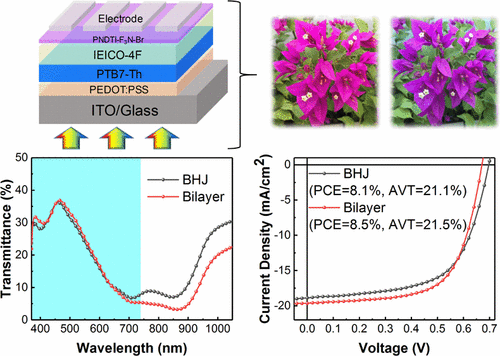当前位置:
X-MOL 学术
›
ACS Appl. Mater. Interfaces
›
论文详情
Our official English website, www.x-mol.net, welcomes your
feedback! (Note: you will need to create a separate account there.)
Semitransparent Organic Solar Cells Enabled by a Sequentially Deposited Bilayer Structure.
ACS Applied Materials & Interfaces ( IF 8.3 ) Pub Date : 2020-04-07 , DOI: 10.1021/acsami.0c00396 Yu Song 1 , Kai Zhang 1 , Sheng Dong 1 , Ruoxi Xia 1 , Fei Huang 1 , Yong Cao 1
ACS Applied Materials & Interfaces ( IF 8.3 ) Pub Date : 2020-04-07 , DOI: 10.1021/acsami.0c00396 Yu Song 1 , Kai Zhang 1 , Sheng Dong 1 , Ruoxi Xia 1 , Fei Huang 1 , Yong Cao 1
Affiliation

|
Semitransparent organic solar cells (ST-OSCs) have been regarded as a promising candidate for building integrated photovoltaics. In general, most of the ST-OSCs are based on a bulk heterojunction (BHJ) structure in which the morphology of the BHJ film must be delicately optimized. In this work, we introduce a sequentially deposited bilayer structure into ST-OSCs by using a PTB7-Th/IEICO-4F combination. The adoption of the bilayer structure not only simplifies the device optimization, but it is also found that, as the donor and the acceptor are separately deposited, the power conversion efficiency (PCE) of bilayer ST-OSCs can be improved by simply increasing the thickness of IEICO-4F, which has strong near infrared absorption but weak visible light absorption, without significantly affecting the average visible light transmittance (AVT) of the device. However, in the BHJ structure, the increase in BHJ film thickness unavoidably enhances the donor absorption in the visible light region, leading to a tradeoff between the PCE and AVT in BHJ-structured ST-OSCs. Eventually, the bilayer-structured device exhibits a better overall performance than the BHJ-structured device, e.g., a PCE of 8.5% for the bilayer structure versus a PCE of 8.1% for the BHJ structure with an AVT around 21%. Our findings indicate that the sequentially deposited bilayer structure, aside from its easy processing characteristics, also has great potential for preparing high-performance ST-OSCs.
中文翻译:

通过顺序沉积的双层结构实现的半透明有机太阳能电池。
半透明有机太阳能电池(ST-OSC)被认为是构建集成光伏电池的有前途的候选者。通常,大多数ST-OSC基于体异质结(BHJ)结构,其中BHJ膜的形态必须精细优化。在这项工作中,我们通过使用PTB7-Th / IEICO-4F组合将顺序沉积的双层结构引入ST-OSC。双层结构的采用不仅简化了器件优化,而且还发现,由于施主和受主分开沉积,可以通过简单地增加厚度来提高双层ST-OSC的功率转换效率(PCE)。 IEICO-4F,它具有很强的近红外吸收能力但可见光吸收能力很弱,不会明显影响设备的平均可见光透射率(AVT)。然而,在BHJ结构中,BHJ膜厚度的增加不可避免地增加了可见光区域中的供体吸收,导致在BHJ结构的ST-OSC中PCE和AVT之间的折衷。最终,双层结构的器件表现出比BHJ结构的器件更好的整体性能,例如,双层结构的PCE为8.5%,而BHJ结构的PCE为8.1%,AVT约为21%。我们的发现表明,顺序沉积的双层结构除具有易于加工的特性外,还具有制备高性能ST-OSC的巨大潜力。导致在BHJ结构的ST-OSC中PCE和AVT之间进行权衡。最终,双层结构的器件表现出比BHJ结构的器件更好的整体性能,例如,双层结构的PCE为8.5%,而BHJ结构的PCE为8.1%,AVT约为21%。我们的发现表明,顺序沉积的双层结构除具有易于加工的特性外,还具有制备高性能ST-OSC的巨大潜力。导致在BHJ结构的ST-OSC中PCE和AVT之间进行权衡。最终,双层结构的器件表现出比BHJ结构的器件更好的整体性能,例如,双层结构的PCE为8.5%,而BHJ结构的PCE为8.1%,AVT约为21%。我们的发现表明,顺序沉积的双层结构除具有易于加工的特性外,还具有制备高性能ST-OSC的巨大潜力。
更新日期:2020-04-23
中文翻译:

通过顺序沉积的双层结构实现的半透明有机太阳能电池。
半透明有机太阳能电池(ST-OSC)被认为是构建集成光伏电池的有前途的候选者。通常,大多数ST-OSC基于体异质结(BHJ)结构,其中BHJ膜的形态必须精细优化。在这项工作中,我们通过使用PTB7-Th / IEICO-4F组合将顺序沉积的双层结构引入ST-OSC。双层结构的采用不仅简化了器件优化,而且还发现,由于施主和受主分开沉积,可以通过简单地增加厚度来提高双层ST-OSC的功率转换效率(PCE)。 IEICO-4F,它具有很强的近红外吸收能力但可见光吸收能力很弱,不会明显影响设备的平均可见光透射率(AVT)。然而,在BHJ结构中,BHJ膜厚度的增加不可避免地增加了可见光区域中的供体吸收,导致在BHJ结构的ST-OSC中PCE和AVT之间的折衷。最终,双层结构的器件表现出比BHJ结构的器件更好的整体性能,例如,双层结构的PCE为8.5%,而BHJ结构的PCE为8.1%,AVT约为21%。我们的发现表明,顺序沉积的双层结构除具有易于加工的特性外,还具有制备高性能ST-OSC的巨大潜力。导致在BHJ结构的ST-OSC中PCE和AVT之间进行权衡。最终,双层结构的器件表现出比BHJ结构的器件更好的整体性能,例如,双层结构的PCE为8.5%,而BHJ结构的PCE为8.1%,AVT约为21%。我们的发现表明,顺序沉积的双层结构除具有易于加工的特性外,还具有制备高性能ST-OSC的巨大潜力。导致在BHJ结构的ST-OSC中PCE和AVT之间进行权衡。最终,双层结构的器件表现出比BHJ结构的器件更好的整体性能,例如,双层结构的PCE为8.5%,而BHJ结构的PCE为8.1%,AVT约为21%。我们的发现表明,顺序沉积的双层结构除具有易于加工的特性外,还具有制备高性能ST-OSC的巨大潜力。































 京公网安备 11010802027423号
京公网安备 11010802027423号